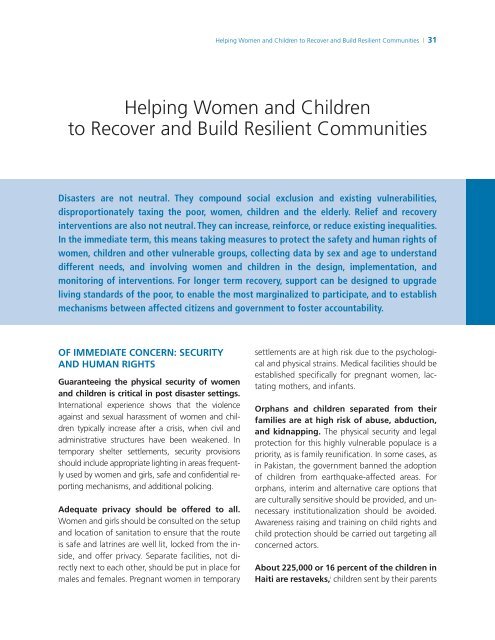Haiti Earthquake Reconstruction Knowledge Notes from ... - GFDRR
Haiti Earthquake Reconstruction Knowledge Notes from ... - GFDRR
Haiti Earthquake Reconstruction Knowledge Notes from ... - GFDRR
You also want an ePaper? Increase the reach of your titles
YUMPU automatically turns print PDFs into web optimized ePapers that Google loves.
Helping Women and Children to Recover and Build Resilient Communities | 31<br />
Helping Women and Children<br />
to Recover and Build Resilient Communities<br />
Disasters are not neutral. They compound social exclusion and existing vulnerabilities,<br />
disproportionately taxing the poor, women, children and the elderly. Relief and recovery<br />
interventions are also not neutral. They can increase, reinforce, or reduce existing inequalities.<br />
In the immediate term, this means taking measures to protect the safety and human rights of<br />
women, children and other vulnerable groups, collecting data by sex and age to understand<br />
different needs, and involving women and children in the design, implementation, and<br />
monitoring of interventions. For longer term recovery, support can be designed to upgrade<br />
living standards of the poor, to enable the most marginalized to participate, and to establish<br />
mechanisms between affected citizens and government to foster accountability.<br />
OF IMMEDIATE CONCERN: SECURITY<br />
AND HUMAN RIGHTS<br />
Guaranteeing the physical security of women<br />
and children is critical in post disaster settings.<br />
International experience shows that the violence<br />
against and sexual harassment of women and children<br />
typically increase after a crisis, when civil and<br />
administrative structures have been weakened. In<br />
temporary shelter settlements, security provisions<br />
should include appropriate lighting in areas frequently<br />
used by women and girls, safe and confidential reporting<br />
mechanisms, and additional policing.<br />
Adequate privacy should be offered to all.<br />
Women and girls should be consulted on the setup<br />
and location of sanitation to ensure that the route<br />
is safe and latrines are well lit, locked <strong>from</strong> the inside,<br />
and offer privacy. Separate facilities, not directly<br />
next to each other, should be put in place for<br />
males and females. Pregnant women in temporary<br />
settlements are at high risk due to the psychological<br />
and physical strains. Medical facilities should be<br />
established specifically for pregnant women, lactating<br />
mothers, and infants.<br />
Orphans and children separated <strong>from</strong> their<br />
families are at high risk of abuse, abduction,<br />
and kidnapping. The physical security and legal<br />
protection for this highly vulnerable populace is a<br />
priority, as is family reunification. In some cases, as<br />
in Pakistan, the government banned the adoption<br />
of children <strong>from</strong> earthquake-affected areas. For<br />
orphans, interim and alternative care options that<br />
are culturally sensitive should be provided, and unnecessary<br />
institutionalization should be avoided.<br />
Awareness raising and training on child rights and<br />
child protection should be carried out targeting all<br />
concerned actors.<br />
About 225,000 or 16 percent of the children in<br />
<strong>Haiti</strong> are restaveks, i children sent by their parents

















